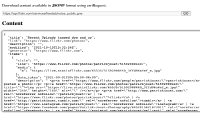 Hide Table of Contents
Hide Table of Contents
 Analysis
Analysis
 Dynamic Layers
Dynamic Layers
 Editing
Editing
 Feature Layers
Feature Layers
 Feature Table
Feature Table
 Graphics
Graphics
 Map
Map
 Mobile
Mobile
 Online and Portal
Online and Portal
 Popups and Info Windows
Popups and Info Windows
 Query and Select
Query and Select
 Renderers, Symbols, Visualization
Renderers, Symbols, Visualization
 Search
Search

Explore in the sandbox
Open in CodePen
View live sample
Description
This sample shows how to use esriRequest to download content in JSONP format. The snippet below uses this method to retrieve pictures from a Flickr feed. Note that the request property callbackParamName is set to"jsoncallback". The Flickr API requires the callback function name to be passed in a URL query parameter named 'jsoncallback'. If you are working with theArcGIS REST API, set the parameter name to "callback". For other APIs consult their documentation to determine the proper callback function name.
Once the content is loaded we can access and display this information. The dojo.toJson method is used to convert the JavaScript object and its properties and values into simple text.
The other "Access data" samples in this folder require a proxy since they call out to other servers to access content. This sample does not require a proxy because it downloads content in JSONP format. JSONP is a subset of JavaScript Object Notation (JSON) which lets the server provide information quickly in an easy to read format. JSONP requests are padded, hence the P, to make calls to another server.
Code
<!DOCTYPE html>
<html>
<head>
<title>JSONP Content</title>
<meta http-equiv="Content-Type" content="text/html; charset=utf-8">
<link rel="stylesheet" href="https://js.arcgis.com/3.46/esri/css/esri.css">
<style>
body{
font-family: "Arial Unicode MS, Arial, sans-serif";
}
#content {
width: 800px; height: 350px; padding: 5px; overflow: auto;
border: solid 2px #AAAAAA; background-color: #FFFFFF;
border-radius: 5px;
-moz-box-shadow: 0 0 0.5em black; -webkit-box-shadow: 0 0 0.5em black; -o-box-shadow: 0 0 0.5em black; box-shadow: 0 0 0.5em black;
}
.failure { color: red; }
#status { font-size: 12px; }
</style>
<script src="https://js.arcgis.com/3.46/"></script>
<script>
require(["dojo/dom", "dojo/on", "dojo/dom-class", "dojo/_base/json", "esri/request", "dojo/domReady!"], function(dom, on, domClass, dojoJson, esriRequest) {
dom.byId("url").value = "https://api.flickr.com/services/feeds/photos_public.gne";
dom.byId("content").value = "";
//handle the Go button's click event
on(dom.byId("submitRequest"), "click", getContent);
function getContent(){
var contentDiv = dom.byId("content");
contentDiv.value = "";
domClass.remove(contentDiv, "failure");
dom.byId("status").innerHTML = "Downloading...";
//get the url
var url = dom.byId("url").value;
var requestHandle = esriRequest({
"url": url,
"content": {
"tags": "dog,us",
"tagmode": "all",
"format": "json"
},
"handeAs": "json",
"callbackParamName": "jsoncallback"
});
requestHandle.then(requestSucceeded, requestFailed);
}
function requestSucceeded(response, io){
dom.byId("status").innerHTML = "";
dojoJson.toJsonIndentStr = " ";
dom.byId("content").value = dojoJson.toJson(response, true);
}
function requestFailed(error, io){
domClass.add(dom.byId("content"), "failure");
dom.byId("status").innerHTML = "";
dojoJson.toJsonIndentStr = " ";
dom.byId("content").value = dojoJson.toJson(error, true);
}
});
</script>
</head>
<body>
<p>Download content available in <b>JSONP</b> format using esriRequest. </p>
<p>
<input type="text" disabled="true" id="url" size="100"/>
<input id="submitRequest" type="button" value="GO" />
<span id="status"></span>
</p>
<h2>Content</h2>
<textarea id="content"></textarea>
</body>
</html>